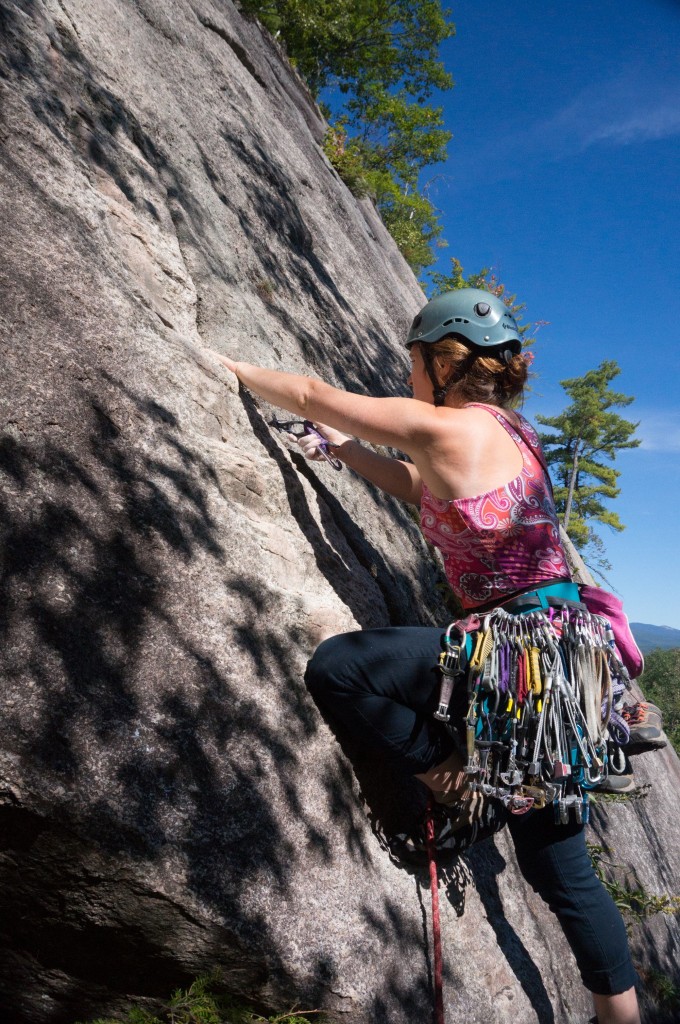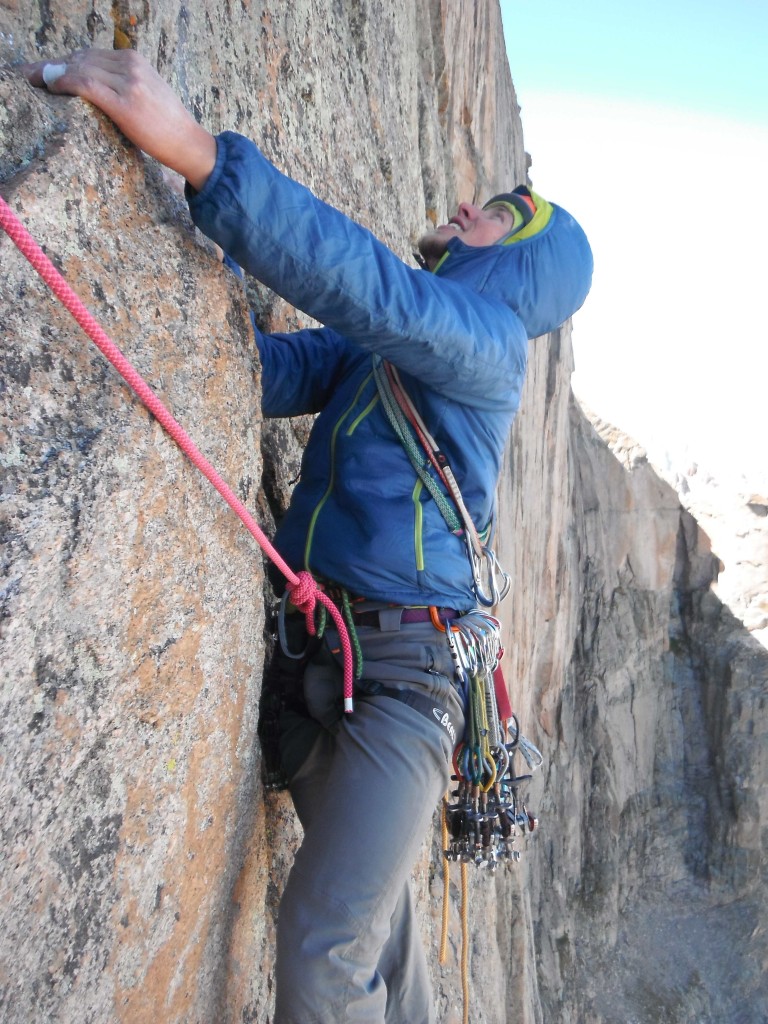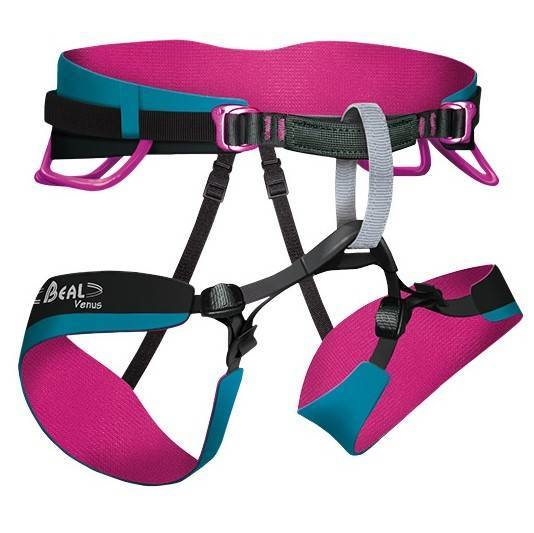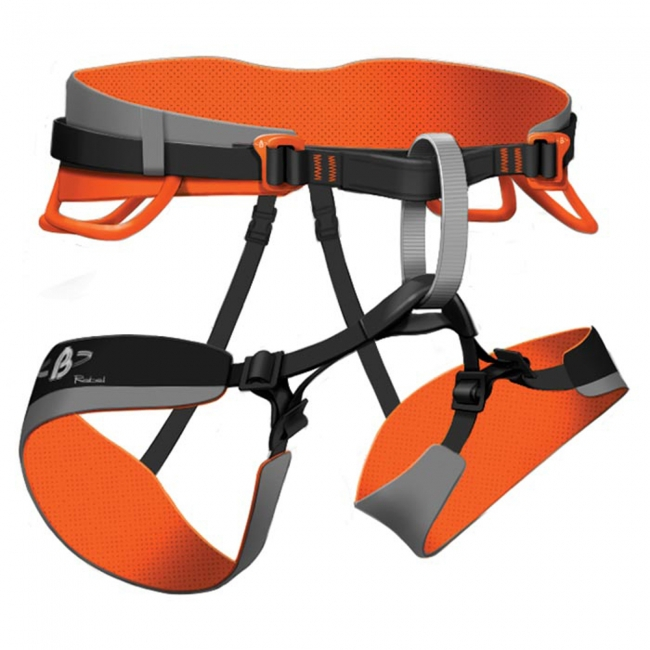A combined-gender review: both men’s and women’s versions
If you’re a woman, I imagine you might be frustrated by the pervasive lack reviews for female-specific gear. At The Climbing Zine we feel it’s important to provide objective information to everyone, so I partnered with Lilly Hancock to test both the men’s and women’s versions of Beal’s sleek new harnesses.
by Drew Thayer, Senior Contributor
Retail: $75.95
What’s new in climbing harnesses these days? Flat-weave webbing construction is back in vogue, but unlike the swami belts of yesteryear, modern designs incorporate a high-density flat webbing that spreads surface area and removes bar-tack stitches from pressure points. It’s a tricky balancing act: the lack of padding would seem to be uncomfortable, but if shaped correctly, a flat-webbing harness spreads pressure evenly across the hips and is actually quite comfortable while being much less bulky.
For a while this design was only available from Arc’Teryx with a high price tag, but in the last couple years Black Diamond, Edelrid, and Beal have followed suit and greatly expanded the range of designs and affordability of flat-webbing harnesses. How do the new Beal harnesses compare?
We tested Beal’s all-around rock climbing harnesses, Rebel and Venus. These are sleek minimalist harnesses built of low-volume flat webbing, with four medium-size gear loops and a small haul loop on the rear. Here’s how the Rebel and Venus harnesses perform:
Two buckles create a super-adjustable fit: Getting a harness centered on your hips can be a pain if you’re in-between a brand’s sizes. I can’t even wear Black Diamond harnesses because the gear loops are so far off-center that they’re hard to reach one side. We love the quick-adjust buckle on either side of the belay loop on these Beal harnesses because we can always center the harness perfectly, and they’re very quick to put on. The Rebel and Venus harnesses fit incredibly well.

The Venus harness comfortably holds a full rack of cams right where Lilly wants them for splitter granite on Cathedral Ledge, New Hampshire Photo Drew Thayer
We both agree that the auto-adjusting elastic leg loops are an improvement over buckled designs. These cinch tightly around the upper thigh and stay right where you need them to hold your weight while hanging on the rope. No need to tighten a buckle, although I find that the plastic tri-glides need to be adjusted from time to time, which is easy with a push of the fingers.
Sizing: The Rebel and Venus come in two sizes each (1 and 2), designed to fit either side of a 75 cm (29.5 inch) waist. If you’re near that middle ground, Lilly recommends going with the larger size (2) as it lets her cinch the gear loops all the way forward for easier access to cams while on lead.
Durable flat-weave webbing has shown minimal wear, even after considerable thrutching in off-widths and Vedauwoo. The leg loops on Lilly’s Black Diamond Momentum harness shredded from a few years of crack climbing, so she appreciates the Venus’ sleek, resilient design.
Comfort: Accessibility features are nice, but the bottom line for most people will be comfort. How do these innovations compare to padded harnesses? Our experience with the Rebel and Venus harnesses is that the flat webbing does a good job distributing weight evenly over a few layers of clothing, and is ideal for climbing in the mountains or at a chilly day at the crag where a micro-fleece and a windbreaker add some padding. On warm days, however, the edges of the webbing became a problem.
Rebel: I find the Rebel to be about as comfortable as my padded Mammut harness on my straight-hipped frame, but after climbing shirtless for several hours on Shelf Road limestone, I had raw sores on my hips from the edge of the webbing pinching my skin. This has not been my experience with padded harnesses, or with the Arc’teryx flat-weave harnesses.

The slender Rebel Harness is comfortable over a few layers during a chilly September ascent of D7, Longs Peak, Colorado. Photo: Tucker Hancock
Venus: Lilly observes that for women with hips, the thin lower edge of the waist webbing can dig into the skin while hanging, even with a shirt on, a painful annoyance she didn’t notice with her padded Momentum harness.
Light weight and compact: at 365 grams (12.9 oz) and 400 grams (14.1 oz), for size 1 and 2, respectively, these are on-par with light-weight all-around harnesses like the Black Diamond Chaos and Aspect, Petzl Sama, and Arc’Teryx AR 395a. The most beneficial feature of the flat-webbing design is how compressible these harnesses are. Lilly appreciates how little room the Venus takes up compared to her old Momentum harness; she can easily cram it into a small climbing pack on the approach and leave plenty of room for warm jackets and water.
An affordable option for all-around rock climbing: The Rebel and Venus have the minimum necessities for an all-around rock climbing harness. The medium-sized gear loops should carry everything you need on sport climbs or moderate-length trad climbs. Lack of ice clipper slots or a rear 5th gear loops don’t make this a good choice for alpine or big-wall climbing.
While the webbing on these Beal harnesses is quite stiff and flat, Black Diamond Aspect ($85) and Chaos ($125) harnesses incorporate a softer, thicker material and are a bit more comfortable to hang in.
For a true flat-webbing harness, the Arc’Teryx AR-395a has bigger gear loops, a rear accessory loop, ice clipper slots, and is a bit more comfortable, but costs $160. That’s over twice as much! Is that extra $85 worth it? Unless you’re climbing hard in big terrain, probably not.
[For a comprehensive review of the Arc’Teryx all-around AR-395a, see here: https://climbingzine.com/review-arcteryx-ar-395a-harness/]
Bottom line: Given the price, the Rebel and Venus harness are a fantastic value. The dual buckle design and elastic leg loops make them the best-fitting harnesses we’ve owned. The unique virtues of the flat-webbing design—light weight and minimal bulk—make them optimal for multi-pitch adventures with long approaches. Since these qualities come as some sacrifice to comfort, they’re not the ideal sport climbing harnesses. We love the simplicity and utility of these harnesses while climbing long routes in the mountains, but find the sharp edge of the waist loop a bit uncomfortable over thin clothing. Women with hips will likely prefer a padded harness for repeated hanging and falling at the crag.
Drew Thayer blogs at Carrots and Peanut Butter. He is a Senior Contributor to The Climbing Zine.
Please consider subscribing to The Climbing Zine. It’s $17.99 a year for two issues, and this greatly helps us produce free web content like this.
In the vertical world, quality gear is as important as good weather or the right partner. At the Climbing Zine, we review gear that we put to the test in our personal climbing pursuits, over months of use. If we like it we’ll tell you, and if we don’t we’ll tell you. That’s our policy…If you have gear for us to consider for a review please contact us at luke@climbingzine.com.
About us: The Climbing Zine was started in 2010 by Al Smith III and Luke Mehall. It continues to the day with the mission of representing the true essence of climbing. Our crown jewel is our printed version, but we also do the interweb thing, and Kindle. You can now subscribe to The Climbing Zine as well!
We have also published two books: The Great American Dirtbags and Climbing Out of Bed, both written by publisher, Luke Mehall.









Great review guys. Love how thorough your gear articles are. Been climbing in my Rebel harness for a year now and love that it rolls down to the size of a bagel for bulkless storage in my pack. Haven’t had much issue with comfort myself. The longer you hang in any harness, no matter how much padding, the more uncomfortable you’ll become.